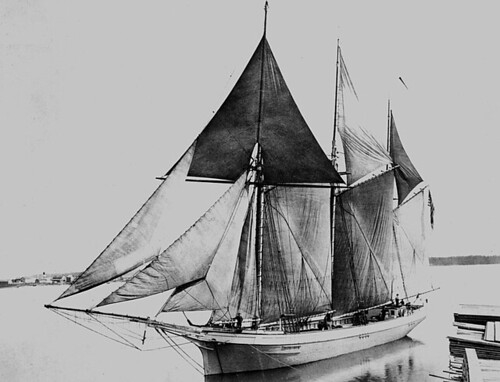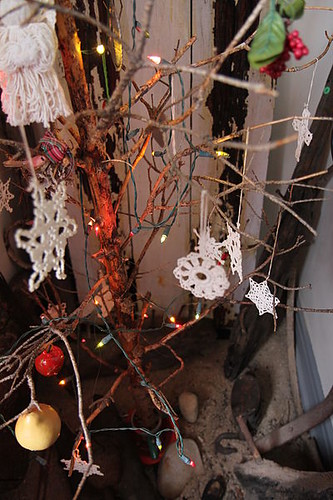Shipwrecks of the Great Lakes: The Rouse Simmons (the Christmas Tree Ship)
The approximate 6,000 ships that have succumbed to raging storms attest to the power of the Great Lakes. As I traveled, writing and compiling information for my three-volume travel series that explores Michigan's coasts, I heard or read the tales left behind by those ill-fated ships. They add a somber, but compelling backdrop to Michigan’s waterways.

Bow of the Rouse Simmons with a Christmas tree placed on her deck. Photo by Wisconsin Historical Society
The Rouse Simmons, known as the Christmas Tree Ship, sank on November 23, 1912. She continues to stir imaginations more than a century after her wreck and may be the best known of all Lake Michigan disasters. Her story is legend, and she is immortalized in songs, plays, a book, and continuing attempts to trace her last route. There were no survivors of the wreck.
The Rouse Simmons is one of the genuine ghost ships of the Great Lakes. A ghost ship is more than a ship that goes down with a loss of lives because such is not an uncommon occurrence. Most of these shipwrecks remain buried and quiet. A true ghost ship is one that is sighted sailing after her demise. Rouse Simmons sightings have been reported by sailors for decades. Her sails are tattered as she continues to limp along the Lake Michigan horizon.
The Rouse Simmons, a three-masted schooner, was bound for Chicago with a very special cargo that lent her the nickname, The Christmas Tree Ship. She carried 5,500 fresh-cut Christmas trees piled deep in her hold and lashed to the deck. She was a floating forest. The trees were intended for sale from the dock in Chicago where they were expected to spread the Christmas spirit to revelers who purchased them.

A photograph taken of the Rouse Simmons "The Christmas Tree Ship". It is suspected to be the last photograph of the ship before it sunk in November 1912. The caption on the photograph states that it was published in the Marine Review in 1913 making it in the public domain in the United States. Wikimedia Commons
The ship was the namesake of Kenosha industrialist Rouse Simmons of Simmons mattress fame. She was built in 1868, was 153-foot long, and weighed 205 tons.

The schooner Rouse Simmons prior to her sinking. Wikimedia Commons
The doomed voyage started with an omen grave enough to cause one crewman to abandon ship. Rats were dropping into the water from the hawser pipe. While landlubbers may think it is a good thing to get rid of rats, when they jump ship, sailors take note. The filthy vermin inhabit ships galleys, and legend warns they desert a sinking ship. If you see them leaving of their own volition, beware. The ship is going down. In this case, it proved true. The Rouse Simmons was last spotted on Saturday afternoon with distress signals flying. She sailed south into a blinding snowstorm.
For many years after she sank, the only evidence of the Rouse Simmons’ fate was pine trees that occasionally became tangled in the nets of commercial fishermen. Then a cork-stopped bottle washed ashore. The message inside read, “Friday. Everybody goodbye. I guess we are all through. Sea washed over our deck board Thursday. During the night, the small boat washed overboard. Leaking bad. Ingvald and Steve fell overboard Thursday. God help us.” –Herman Schuenemann. The note appeared to be part of the captain’s log.

A recovered Christmas tree from the Rouse Simmons ("Christmas Tree Ship") on display at the Port Washington Light Station. The ship sank in 1912. The tree was later recovered when salvaging from shipwrecks was legal. The tree is displayed behind glass and is not accessible. Wikipedia: Royalbroil
In 1924, twelve years after the Simmons went down, Captain Schuenemann’s wallet caught in a fishing net. The contents were intact and legible due to the oilskin that encased it and the rubber band that held it tight. It rekindled memories of the sweet-natured and beloved man who dealt in Yuletide cheer. But the captain may have had a fatal character flaw that contributed to his undoing. Whether it was greed, hardheadedness, or a desire to spread happiness, it was reported that he overloaded the boat with trees to the point where one crewman warned that if they encountered a storm, the boat would be too top heavy to pull through. The captain ignored the warning.
In 1927, a second bottle washed ashore. Inside was a note that read, “These lines are written at 10:30 p.m. Schooner H.S. ready to go down about 20 miles southeast of Two Rivers Point between fifteen or twenty miles off shore. All hands lashed to one line. Goodbye.”—Charles Nelson. (The H.S. refers to Herman Schuenemann.)
While the Rouse Simmons had no radio, and the wreck left no survivors, it was as though the ghosts of this tragedy reached from their watery grave and communicated their story to the living through two notes in bottles and an intact wallet.
The site of the wreck remained a mystery until 1971 when salvager Ken Bellrichard of Milwaukee discovered the Rouse Simmons in 180 feet of water off Rawley Point. Her bones remain nearly intact, and she lies at rest, upright on the floor of the lake. Her cargo hold is still filled with the shrunken remains of Christmas trees.

Wikimedia Commons: Notorious4life
Captain Schuenemann’s wife and daughters continued selling Christmas trees from the deck of a schooner in the Chicago harbor for many years after his death. But the time of Christmas Tree Ships was almost at an end. Wholesale tree farms and better transportation on railroads and highways ended the holiday tradition where revelers headed to the harbor to choose their tree from the deck of a ship.
Captain Schuenemann’s widow lived more than 20 years after his death and upon her death, was laid to rest next to her husband in a Chicago cemetery. Their joint headstone bears a tiny engraved Christmas tree between their names.

"Captain Santa" and two crewmen on the deck of the Rouse Simmons. Photo by Wisconsin Historical Society
Learn more:
https://www.wisconsinshipwrecks.org/Vessel/Details/541
https://www.archives.gov/publications/prologue/2006/winter/christmas-tree.html
Click through to read excerpts from Royce's three books exploring Michigan's coasts:
Julie Albrecht Royce, the Michigan Editor for Wandering Educators recently published a three-book travel series exploring Michigan’s coastlines. Nearly two decades ago, she published two traditional travel books, but found they were quickly outdated. This most recent project focuses on providing travelers with interesting background for the places they plan to visit. Royce has published two novels: Ardent Spirit, historical fiction inspired by the true story of Odawa-French Fur Trader, Magdelaine La Framboise, and PILZ, a legal thriller which drew on her experiences as a First Assistant Attorney General for the State of Michigan. She has written magazine and newspaper articles, and had several short stories included in anthologies. All books available on Amazon.

Help promote Michigan. Books available on Amazon.




















